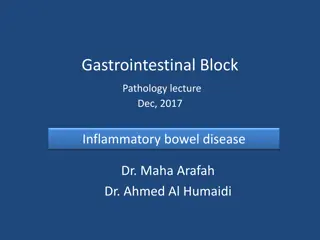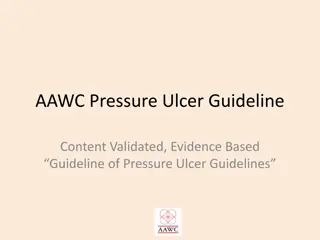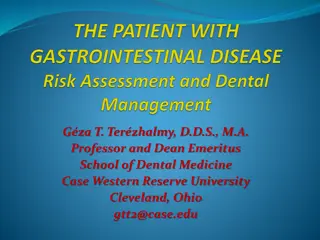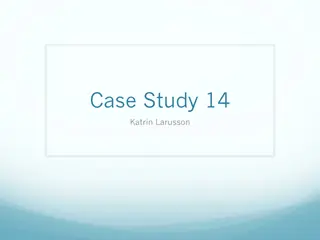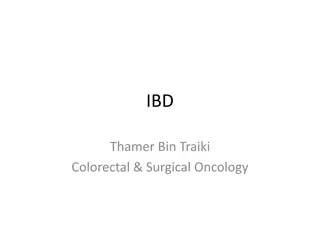Peptic Ulcer Disease: Causes, Symptoms, and Treatment
Peptic ulcer disease (PUD) involves ulcerations in the duodenal or gastric mucosa caused by factors like Helicobacter pylori infection and NSAID use. Symptoms include abdominal pain and nausea, and treatment often involves H. pylori eradication and proton pump inhibitors to prevent complications lik
1 views • 77 slides
Peptic Ulcer Disease: Treatment Approaches and Helicobacter pylori Eradication
Common gastrointestinal conditions such as peptic ulcers can be effectively treated through approaches like eradicating H. pylori infection, reducing gastric acid secretion, and using mucosal protecting agents. Helicobacter pylori eradication is crucial for healing ulcers and preventing recurrence,
2 views • 27 slides
The Natural History of Disease Development and Prevention
The natural history of disease development outlines the progression of a disease in an individual without intervention, from exposure to outcome. Learning objectives include defining prevention terms, understanding disease severity, prevention levels, and intervention measures. Studying disease prog
4 views • 16 slides
Association Between Peptic Ulcer and Periodontitis: Insights and Connections
Previous studies have suggested a potential link between peptic ulcer disease (PUD) and periodontitis. PUD affects the gastrointestinal mucosa, with key risk factors being H. pylori infection and NSAID use, while periodontitis is an inflammatory disease affecting the tissues around teeth. Understand
0 views • 17 slides
Principles of Epidemiology: Understanding Disease Occurrence and Surveillance
Epidemiology is the study of disease patterns, factors influencing disease occurrence, and the core functions of surveillance, field investigation, and analytic studies. It involves understanding disease characteristics, natural history, and evaluating the effectiveness of activities to mitigate dis
1 views • 25 slides
Insights into Tyzzer's Disease: An Overview of a Bacterial Infection in Laboratory Animals
Tyzzer's disease is an acute bacterial infection affecting rodents and rabbits, caused by Clostridium piliforme. Discovered in 1917 by Ernest Tyzzer, the disease is characterized by necrotic lesions in the caecal mucosa, liver, and heart. Initially known as Bacillus piliformis, it was later renamed
2 views • 21 slides
Integrative Care for Stage III Pressure Ulcer Patient
This case presentation focuses on the comprehensive care of a 75-year-old Hispanic male with a stage III pressure ulcer on the sacrum. It includes information on demographics, medical history, medications, subjective and objective assessments, as well as the integration of evidence-based complementa
0 views • 20 slides
Disease Control and Prevention in Epidemiology
This article discusses disease control processes in epidemiology, including reducing disease incidence, duration, and transmission. It covers public policy interventions, elimination, eradication, and extinction of infectious agents. It also highlights preventable causes of disease and different lev
2 views • 10 slides
Peptic Ulcer Disease and Dyspepsia: Causes and Pathogenesis
Peptic ulcer disease and dyspepsia are common gastrointestinal conditions. Dyspepsia presents with upper abdominal pain and may or may not be associated with peptic ulcers. The most prevalent causes of dyspepsia include non-ulcer dyspepsia, GERD, and peptic ulcers. Peptic ulcers account for a signif
0 views • 24 slides
Screening for Peripheral Vascular Disease in Patients with Coronary Artery Disease
Patients with coronary artery disease should be screened for peripheral vascular disease as it is a frequent integrator of global cardiovascular risk. The association of atherosclerosis in various arterial diseases highlights the importance of identifying multisite artery disease. The prevalence and
0 views • 23 slides
Human Disease Symptom Network: Understanding Disease Relationships Through Symptoms and Genes
The Human Disease Symptom Network (HSDN) is constructed using a large-scale medical bibliographic records database to form a network of human diseases based on symptom similarities. By integrating disease-gene associations and protein-protein interaction data, correlations between symptom similarity
1 views • 37 slides
Peptic Ulcers: Causes, Symptoms, and Treatment
Peptic ulcers are open sores that form in the stomach or upper small intestine, leading to symptoms like stomach pain, bloating, and nausea. Common causes include H. pylori infection and NSAID use. Recognizing symptoms, such as burning stomach pain, is crucial for timely diagnosis and management. Se
0 views • 19 slides
Stress Ulcer Prophylaxis in ICU - Adverse Reactions Reporting Guidelines
Guidelines for reporting adverse reactions in Stress Ulcer Prophylaxis in the Intensive Care Unit (SUP-ICU), including definitions of Adverse Reactions (AR), Serious Adverse Reactions (SAR), Adverse Events (AE), Serious Adverse Events (SAE), SARs in SUP-ICU, and SUSARs. Specific conditions considere
0 views • 8 slides
Bacterial Diseases of Fish: Columnaris Disease Overview
Columnaris disease, also known as Saddleback disease, is a common bacterial infection in fish that is often brought about by poor handling and high stress levels. This disease manifests as tail and fin rot, leading to rapid fish mortality. The causative organism, Cytophaga (formerly Flexibacter), is
0 views • 21 slides
Pressure Ulcer Risk Assessment with the Braden Scale
Pressure ulcer risk assessment is crucial in healthcare settings to identify individuals at risk of developing pressure ulcers. The Braden Scale, developed in 1984, evaluates six key elements contributing to pressure ulcer development. It provides a standardized method for assessing risk levels base
0 views • 20 slides
Peptic Ulcers: Causes, Symptoms, and Nutritional Management
Shahid Virpatni Laxmi Mahavidyalaya conducted a presentation on gastrointestinal (GI) disorders, focusing on peptic ulcers. The content covers the etiology, symptoms, and nutritional management of peptic ulcers, emphasizing the importance of proper diet in managing this condition. Peptic ulcers, cha
0 views • 8 slides
Overview of Stomach Surgery and Treatment Options
The stomach plays a crucial role in digestion and is divided into four regions - cardia, fundus, body, and pyloric part. Understanding the anatomy of the stomach is essential for surgical interventions, including treatment for benign and malignant gastric diseases like peptic ulcer disease. Surgical
0 views • 30 slides
Peptic Ulcer: Symptoms, Diagnosis, and Treatment
Peptic ulcers are holes in the gut lining of the stomach, duodenum, or esophagus. This condition can present with symptoms like upper abdominal pain, bloating, and dark stools. Risk factors include smoking, stress, and certain medications. Diagnosis involves various tests, and treatment includes ant
0 views • 15 slides
Peptic Ulcers: Causes, Prevalence, and Treatment
Peptic ulcers are circumscribed ulcerations in the gastrointestinal mucosa, commonly caused by Helicobacter pylori infection. They have a higher prevalence in developing countries and are associated with factors like socioeconomic status, poor hygiene, and genetic links. While peptic ulcers naturall
0 views • 54 slides
Decoding Genetics: Insights from Alzheimer's Disease Symposium to Type 2 Diabetes Study
Explore the latest findings from the Alzheimer's Disease Genetics Symposium 2019 on disease mechanisms, drug targets, and genetic pathways. Dive into the progress made by the Alzheimer's Disease Genetics Consortium over the past decade. Transition to a Genome-Wide Association Study uncovering suscep
0 views • 42 slides
Liver Disease Burden in Tower Hamlets
Dr. Somen Banerjee, Director of Public Health in London Borough Tower Hamlets, highlights the concerning liver disease mortality rates in the area, with high incidence of cirrhosis, cancer, and hepatitis B and C. The data reveals a significant burden of liver diseases such as Non-Alcoholic Fatty Liv
0 views • 18 slides
Inflammatory Bowel Disease: Crohn's Disease and Ulcerative Colitis
Inflammatory Bowel Disease (IBD) encompasses Crohn's disease (CD) and ulcerative colitis (UC), chronic conditions with immunologic basis. This article delves into the epidemiology, pathophysiology, and differences between CD and UC, highlighting clinical features, pathology, and complications like a
0 views • 42 slides
Ultrastructural Alterations of Renal Tissue in a Male Patient with Fabry's Disease
Fabry's disease is a rare X-linked lipid storage disorder characterized by deficient lysosomal alpha-galactosidase A activity. This condition primarily affects males, leading to chronic kidney disease and progression to end-stage renal disease. Kidney involvement is a critical aspect, and high doses
0 views • 24 slides
AAWC Pressure Ulcer Guideline: Managing Pressure Ulcers Effectively
This content outlines the AAWC Pressure Ulcer Guideline, providing evidence-based recommendations for assessing, preventing, and treating pressure ulcers. The guideline emphasizes the importance of regular skin assessment, personalized care plans, and interdisciplinary wound care management to impro
0 views • 15 slides
Tissue Viability and Pressure Ulcer Prevention Practices in Healthcare
Helen Harris, a Tissue Viability Nurse Specialist, oversees the management and advice for service users with complex wounds, advanced therapies, and pressure ulcer prevention cases. Her role includes developing strategies, policies, and procedures for Tissue Viability services, catering to a populat
0 views • 14 slides
Stress Ulcer Prophylaxis in ICU Data Entry System - SUP-ICU Overview
Dive into the Stress Ulcer Prophylaxis in the Intensive Care Unit (SUP-ICU) data entry system led by Dr. Soeren Marker Jensen. Explore screening, randomization, site overview, and data entry processes. Access participant details, edit submitted data, and learn about data entry guidelines. Enter the
0 views • 28 slides
Viral Pathogenesis: Causes and Consequences
Viral pathogenesis involves the process by which a virus leads to disease, exploring the interplay between viral and host factors. It encompasses the concepts of virulence, viral disease, and the effects on infected cells and the host's immune response. Changes within infected cells, including cell
0 views • 26 slides
Peptic Ulcer Disease
Peptic Ulcer Disease involves a break in the gastrointestinal mucosa, commonly caused by factors such as H. pylori infection and NSAIDs. Symptoms vary between gastric and duodenal ulcers, with pain, nausea, vomiting, and more. Understanding the differences in incidence, etiology, and clinical presen
0 views • 23 slides
Exploring the History and Evolution of Coeliac Disease
Samuel Gee's pivotal clinical description of coeliac disease in 1887 unraveled a chain of discoveries leading to the understanding of its genetic and immunological roots. Early connections between wheat and the disease shed light on the domestication of wheat and its impact on human health. Recent i
0 views • 23 slides
Peptic Ulcer Disease
Peptic ulcer disease involves breaches in the mucosa of the stomach or duodenum, with causes ranging from H. pylori infection to NSAID use. Understanding its pathophysiology and clinical features is crucial for proper management. Explore the defensive and aggressive factors contributing to ulcer for
0 views • 23 slides
Peptic Ulcer Disease
Peptic ulcer disease involves lesions in the lower esophagus, stomach, pylorus, or duodenum. Explore the pathophysiology, clinical manifestations, and etiology of peptic ulcers, including factors like Helicobacter pylori infection, NSAID-induced ulcers, hypersecretion of acid, and genetic predisposi
0 views • 18 slides
Peptic Ulcer & Oral Health
Peptic Ulcer Disease (PUD) is a common condition affecting the stomach and duodenum, with potential effects on oral health. This article discusses the causes, symptoms, and oral manifestations of PUD, highlighting the link with H. Pylori infection and periodontitis. Learn about tips for oral care an
0 views • 18 slides
Patient with Gastrointestinal Disease - Understanding GERD and PUD
In this comprehensive presentation, Dr. Gza T. Terzhalmy discusses Gastroesophageal Reflux Disease (GERD) and Peptic Ulcer Disease (PUD). Explore the mechanisms of action of proton pump inhibitors, risk assessment factors, symptoms of GERD and PUD, treatment strategies, and more. Gain insights into
0 views • 10 slides
Impact of Nursing Intervention Protocol on Peptic Ulcer Patients' Clinical Outcome
Peptic ulcer disease is prevalent globally, with varying incidences across different regions. This study focuses on the impact of implementing a designed nursing intervention protocol on the clinical outcome of patients with peptic ulcers, emphasizing the importance of nursing assessment, goals, and
0 views • 25 slides
MRCS PART A: Upper GI surgery
A case study involving acute pancreatitis leading to ARDS and the management of ARDS. Discussion on causes, definition, and treatment strategies. Another case study on H. pylori infection and peptic ulcer disease with emphasis on endoscopic management and applied anatomy.
0 views • 8 slides
Stress Ulcer Prophylaxis in the Intensive Care Unit (SUP-ICU)
Critically ill patients in the intensive care unit are at risk of gastrointestinal bleeding. The SUP-ICU trial aims to assess the benefits and harms of stress ulcer prophylaxis in adult ICU patients, considering potential risks like pneumonia, Clostridium difficile infection, and cardiovascular even
0 views • 11 slides
Case Study: Katrin Larusson's Complex Clinical Presentation
This case study delves into the intricate clinical scenario of a 70-year-old male presenting with dysentery, duodenal ulcer, dilated cardiomyopathy, and multiple comorbidities. It explores vital signs, past medical history, duodenum ulcer causes, patient's medications, plan of care, and potential pr
0 views • 30 slides
Peptic Ulcer Disease
A breakdown of peptic ulcer disease including its definition, types (gastric & duodenal), epidemiology, etiology, clinical presentation, and differential diagnosis. Learn about the incidence, symptoms, and contributing factors of duodenal and gastric ulcers. Understand the key differences between du
0 views • 20 slides
Understanding Inflammatory Bowel Disease (IBD) and Crohn's Disease
Inflammatory bowel disease (IBD) encompasses conditions like ulcerative colitis and Crohn's disease, with distinguishing factors based on clinical and pathologic criteria. Crohn's disease is a chronic inflammatory condition affecting the gastrointestinal tract with both medical and surgical treatmen
0 views • 51 slides
PSYCHOSOMATIC DISORDERS
Psychosomatic disorders involve the interaction between mind and body, where emotional stress contributes to physical problems. Learn about the definition, etiology, personality factors, and common disorders like asthma and peptic ulcer.
0 views • 11 slides





















